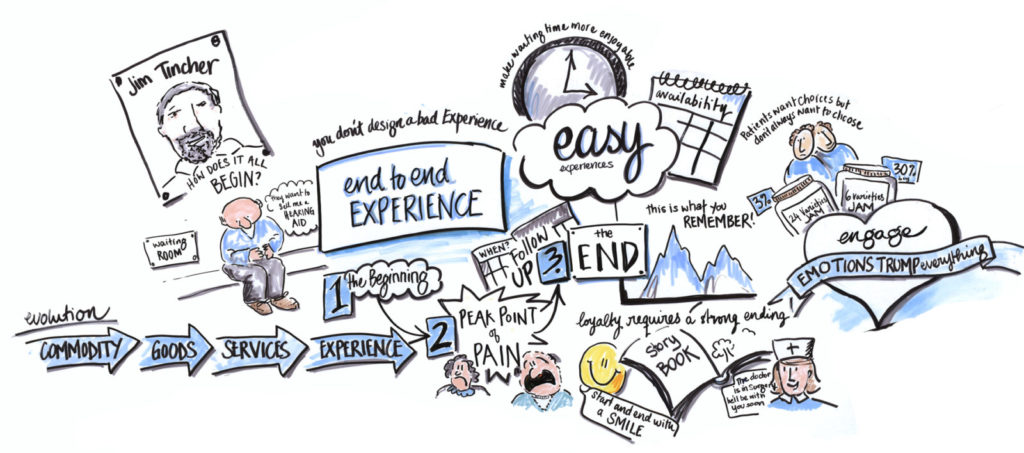To answer this, it is important to understand what customer journey mapping is. Journey mapping is a tool used to visually represent the step-by-step interaction of a customer with a brand or company from beginning to the end. Fundamentally, a journey map encourages a company put on a customer’s spectacles and look through their eyes, “walking” through their process, step by step, rather than from how the process is seen from within.
How to map a journey
- Agree on the purpose: The reasons for wanting to map customers’ journeys, may vary for every organisation, but it is essential to have clarity on why it is required and what will be done with the map. A map can either reflect the current journey and experience, or it can reflect the desired journey, or a combination on these. It can be crafted as a high-level visualization of the stages and the individual steps; or it can be very detailed, even including the “backstage” or internal processes. The purpose dictates the scope of the map.
- Involve the right stakeholders: Ideally a cross-functional team should participate in the design to look at the journey from all aspects of the business. Leadership involvement is important but ultimately the most suited team members should to be involved, rather than the most senior.
- Where to start: A persona should be developed, representing a typical customer (one person), although more than one persona can be used, if their journeys are very different. As an example, one persona may be a young millennial, while another may be a retired individual. Their approaches and experience will be vastly different. It is important to note that is not necessary to design a map for every possible type of customer, as the process of designing a map, with one person in mid, in itself, provides the collective framework of thinking – customer first – for the design teams. To choose and define a persona, requires insight into a person’s world. The following type of information will provide a more complete picture: who they are individuals, work, lifestyle, values, beliefs, preferences, their fears and challenges, dreams and aspirations and what problems they want to solve. This information is obtained through existing data or new research. Once a person (persona) has been identified, and a more complete “picture” of the person has been created, this framework or mindset, is then used to place one’s entire design process through the perspective of such a person. This process is referred to as empathy building and empathy maps are widely used for this. Throughout this “persona’s” journey, the team is constantly reminded to project and assume the interaction with the company through the person’s (persona’s) eyes, what this person will be thinking, doing, feeling etc. at each step.
- How to get information about what customers want, need or experience: Typically, the VOC (Voice of the Customer) is a primary resource for “filling in these gaps” when designing the journey. Using the VOC, positive or negative experiences and frustrations of customers can be identified. Other sources include previous research, social media, complaints management content etc. Staff, especially frontline staff, are also a great source of information around customers’ experience, challenges, reactions and frustrations. Ideally, having “real” customers involved in a later stage of designing, will provide the richest and most robust map.
- What to include in the design process: The map will typically include unpacking and defining themes, from the persona’s perspective, along their journeys. These include the stages and steps of the end-to-end journey, touchpoints, channels, problems to solve, needs, moments of truth, current emotional experience, desired experience/opportunities, even failed experiences. Maps generally start on a high level, outlining the broad step by step journey, before the more detailed unpacking of the journey starts. The frameworks for designing customer journey maps can include as many elements as required, or can determined by level of design expertise, customer insights, time and budget.
- How to design the journey: Mostly customer experience professionals facilitate the design process in a workshop format. The design teams generally consist of cross-functional representatives. The selection should not be based on seniority, but rather relevance and contribution. A large canvas (often placed on wall) is prepared with the elements of the journey. Post-it notes are then used in the collaboration process, to add the different ideas of all the participants, to the canvas. The ideas are then discussed and consolidated.
- What the map should look like: After plotting the journey with content and ideas in the workshop, the process is captured, using a software product – either specifically designed for the purpose, or even Excel. Thereafter, the journey (storyboard) is graphically presented using icons or pictures as an infographic, to illustrate the various steps, as a framework for internal use. The map provides the structure to work on the ideas generated, prioritization and systems, processes that need to be developed to support the desired outcomes. They vary in style, colour and data density but, essentially, the journey map provides a translation of the information, in a visual format.
Benefits of customer journey maps
The benefits of journey mapping are often indirect, as a map itself, is meaningless, unless it is used to improve the customer experience. The value of the process of mapping cannot be emphasized enough. It can be seen in:
Breaking down silos and building collaboration
The most important benefit of customer journey mapping is the collaboration of the cross-functional teams. It helps teams to work together and develop an understanding of customers’ journey, get a joint vision about how to deliver the desired experience and where internal processes impact on experience.
Joint vision around desired experience
Journey mapping highlights the need to craft the experience framework that directs intentionally, how customers SHOULD experience the interaction with a brand (desired service delivery and behaviour).
Focus on the customer
Journey mapping helps to keep the focus on the customer (an outside-in perspective) and sensitize all to the customer’s experience.
Simple visual framework
The journey map provides a simplified visual framework that can be used throughout the business to align internal processes, service delivery and experience or performance tracking frameworks. The visual map should be simple and easy to understand by all levels of staff.
Keeping it real and human
The customer journey mapping helps to identify and be sensitive to their customers’ emotional journey – when they were delighted or disappointed. Everyone in the company should understand the desired experience throughout the journey.
Framework for continuous innovation and improvement
The map is a framework for management and CX workstreams for reviewing VOC and other metrics to measure and track areas to fix, improve or innovate. It ensures that ownership and accountability allocated.
Reduce cost
Journey mapping often simplify processes by reducing duplication of effort and cost, but also by increasing efficiency.
Differentiation
Companies using journey mapping are actively designing their differentiated experience delivery, one of the most valued competitive advantages in business today.
It’s quite evident from the above that consumer journey mapping is an excellent tool to improve the customer experience.
Faced with a “new normal”, partner with The Consumer Psychology Lab, to map your customers’ journey in the post-Covid reality. We are customer experience specialists, with deep routed expertise in extracting the voice of the customer. Our research methodologies provide insights into customers’ realities, needs, experiences and their loyalty. This will help you to identify the changes, gaps and opportunities in the new way of interacting with customers. Contact us at [email protected]






